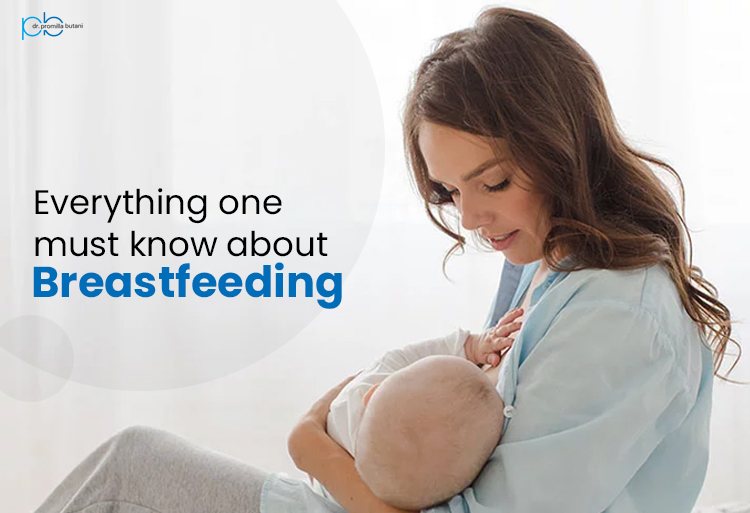Motherhood is one of the most exalted positions.
Breast feeding is an emotionally fulfilling experience both for the mother and the baby.
It takes motherhood to another plane because to nurture your baby, have the breast milk (called ‘AMRIT’ by me), flowing into the baby’s mouth and system can be a truly exhilarating and overwhelming experience for the first time mother or a mother again and again.
Breast feeding is about the wondrous joy of nurturing a new life. Breast feeding is in fact a gift to the mother herself and the baby.
So, happy breastfeeding!
Here are a few tips, do’s and dont’s, benefits to help the mother breast feed her infant with ease.
-
1. Put the baby to the breast as soon as possible after birth.
The baby suckles instinctively.
The uterus contracts and helps control uterine bleeding.
The inseparable bonding starts with the first suckle, it’s an experience to cherish!
-
2. The first milk secreted is called ‘COLOSTRUM’. This is produced in ‘small quantities’. It is thick and yellow, but is rich in calories, proteins and antibodies.
A baby does not need a large amount of feed soon after the birth and does not go hungry if sucking on colostrum. Besides colostrum initiates regular production of milk.
-
3. Sucking frequently at the mother’s breast is of paramount importance.
When a baby sucks at the mother’s breast, a message is sent to the pituitary, which in turn instructs breast to produce more milk.
So more demand more supply, less demand less production of milk/supply- hence, failure of lactation!
-
4. Mothers will often have engorged, swollen, painful breasts in the first few days after birth. This is because the demand and supply chain is not regulated in the first few days.
-
5. The baby must get a soft, supple breast to suck on. So, in case of engorged, painful, lumpy breasts, it is important to physically express milk out either manually or by a pump in the first few days.
-
6. Feed on demand is the dictum, preferably from both breasts, both the fore and hind milk- “fore” is the milk when the baby first suckles and the “hind” the last part of it.
Both have their own qualities! -
7. Babies don’t always suckle because they are hungry. They often keep the nipple in the mouth and snooze because of the secure feeling and bonding that they feel!
-
8. The baby’s stomach size is small so they need to be fed frequently on demand.
-
9. The baby must be taught to put the entire areola (the dark tissues surrounding the nipples) into the mouth while sucking to prevent “sore nipples” in the mother.
-
10. The mother and the baby must be in comfortable positions with a cushion on the back, under the baby, and under the mother’s thigh and the mother can change sides and positions.
-
11. The baby needs to be fed for 15-20-25 minutes each time. So, a comfortable position where the back does not hurt is important.
-
12. Feeding while lying down should be avoided to prevent the baby from getting smothered.
-
13. Since breast milk is tailor made specific for the baby, this milk is easily digestible and less wind/colic producing.
-
14. Breastfed babies often do not need to be burped because the baby digests mother’s milk very easily.
-
15. Babies will often pass bright, yellow watery, frothy stools while they are on the breast. This is because of “gastrocolic reflex”. The moment breast milk goes into the stomach, the intestines gurgle out a stool. This is absolutely normal and should not be of any concern.
-
16. Babies need to be fed night or day but mostly on demand.
-
17. There are no contraindications to breast feeding.
-
18. Diet during lactation.
The mother can eat every food.
There are no do’s and dont’s with her food/diet but a healthy diet goes a long way and she certainly does not need to eat for two. -
19. Babies exclusively breastfed for the first six months without any formula supplements have fewer ear infections, respiratory aliments, allergies, urinary infections and diarrhoeal episodes.
-
20. Breastfeeding reduces the risk of SIDS (sudden infant death syndrome)
-
21. It also reduces the incidence of diabetes and obesity! And it helps the child remain well into the adulthood.
-
22. BREAST FEEDING IS A WIN WIN SITUATION FOR BOTH THE MOTHER AND THE BABY.
-
23. The baby gets milk at the right temperature ready at all times, with warmth and comfort from the mother’s breast.
-
24. Breast milk, tested for centuries is a complete and perfect food for the baby. There is indeed no substitute for mother’s milk.
BREAST FEEDING BLUES
Breast Feeding, however, may not be a very happy experience for some mothers, with the pain and discomfort post delivery, lack of sleep, postpartum depression, swollen painful breasts, intruding interfering “I know it all” mothers in law and mothers and elders! A demanding family and children, sore nipples, back ache to name a few.
So, of course, there “is no pain no gain” adage, but there is also a saying “this too shall pass”.
So, enjoy exclusive breast feeding for six months!
There is no need of water, honey, supplements etc.
Breast milk has more than 80% water, so baby’s need for water is fulfilled by breast milk even in hot dry climates.
Continue to breast feed even after the first six months but add weaning foods to the diet for the babies increased demands!
Breast feed even well after the first year and maybe into the second year as well!
Breast and bottle feed together may cause nipple confusion and the baby may give up the breast for the ease of bottle feed.
